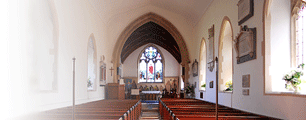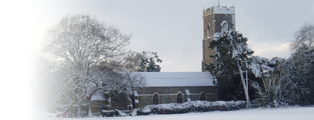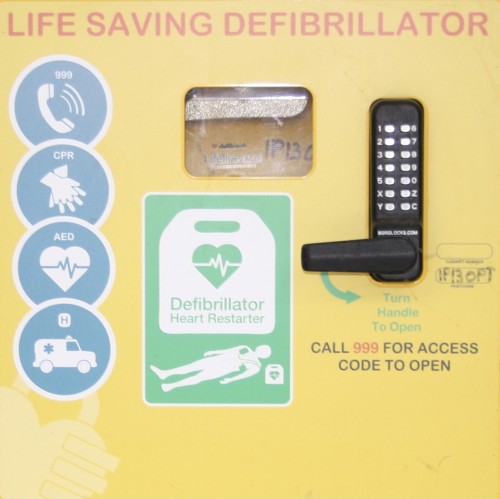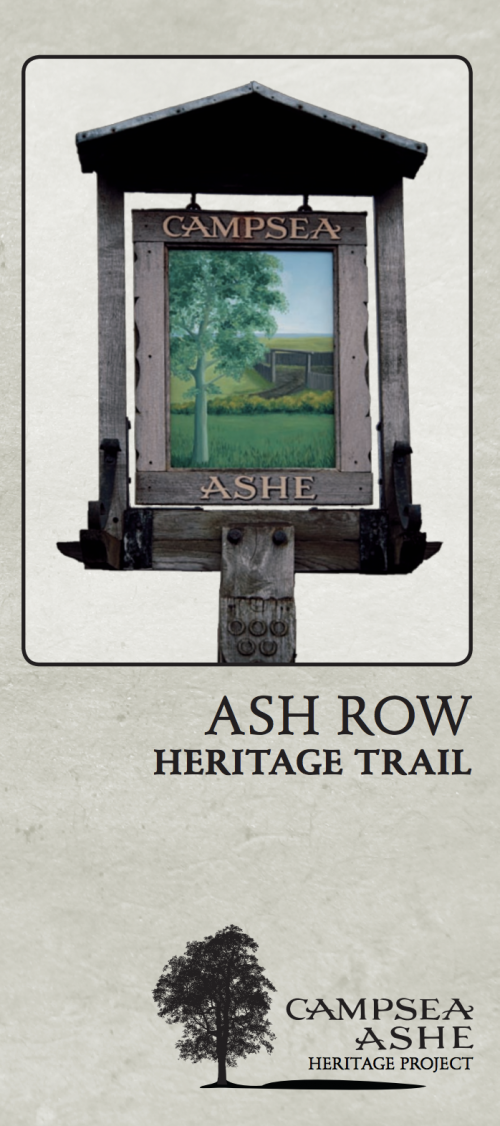Ash Row Trail
Campsea Ashe is best explored using the specially commissioned and informative Heritage Trails.
Download the leaflet by clicking on the image to the left OR collect a free copy from the Church
The second village Heritage Trail explores the village to the west of the church, following a roughly circular route round to “Hellfire Corner” and back along Mill Lane. Passing the Old Rectory and the Iron Room, the road rises over the Railway Bridge towards Wickham Market. The railway bridge was originally built in 1902 on the site of the former level crossing, as part of the ‘down-line’ platform extension work. Some vestiges of the old access road to the level crossing are visible down to the left as you ascend the curved slope of the bridge. Viewed from the top of the bridge, having come from the church, the line to the left goes south towards Woodbridge and Ipswich; to the right it goes towards Saxmundham and Lowestoft. There is also a good view down to the station from the railway bridge, and it can be seen that the former goods yards, sidings and platforms had been quite extensive before the East Suffolk line was reduced to single track in the 1980s.
It is worth walking on to the station platform itself to spend a moment imagining how busy it had been in its heyday. Wickham Market Station (sign-boarded “Wickham Market for Campsea Ashe”) was dual track, with an up-line and a down-line - each with its own platform - a signal box and numerous sidings and goods facilities. Services for passengers included a ticket office, waiting room and bookstall, and the nearby Talbot Hotel (now “The Dog and Duck” village pub). There was especially ample provision for loading goods and livestock to and from the agricultural hinterland, and even ramps for military vehicles during the Second World War. Some vestiges of this infrastructure can be traced today.
The line itself, together with branch lines to Framlingham, Snape and Aldeburgh, was completed in 1859 and train services started on 1 June that year – towards the end of the period of ‘Railway Mania’ that swept Britain during the early part of the 19th Century. The section of line between Ipswich and Halesworth completed the East Suffolk link from the Liverpool Street to Cambridge line to the south west, and the Halesworth, Beccles & Haddiscoe lines further north, with its onward links to Norwich. The railway was instigated by the 1855 East Suffolk Railway Company Prospectus of Sir Samuel Morton Peto, under the chairmanship of the Earl of Stradbroke, and to be funded by a number of prominent local dignitaries; Sir Samuel Peto was already the proprietor of the Halesworth, Beccles & Haddiscoe railway and wished to extend his interests.
Originally the East Suffolk Railway, the line became administered by the Great Eastern Railway (GER) in 1862, followed by the London & North Eastern Railway (LNER) in 1923, and British Railways Eastern Region on nationalisation in 1948. The railway was ‘privatised’ under the Railways Act of 1993.
Passing the village hall on the right, proudly signposted the “Victory Hall” to commemorate the end of hostilities in 1945, when it was built, the Dog and Duck pub sits in the crook of the sharp right-hand bend which takes the road along to the Auction Rooms and Market. These catered for both livestock and ‘deadstock’ until the 1990s but has now become a thriving saleroom – open to the public on Mondays and Wednesdays - for furniture, household goods, vegetables and other assorted market trading. The larger sheds on the market site were used for the sale of farm animals and poultry as well as produce and general goods. Much of this sale produce, including the livestock, was brought into Campsea Ashe by rail.
Immediately beyond the Auction Rooms the road runs beneath the double line of pylons and passes Ash Row and the Village Stores, starting a shallow descent towards Hellfire Corner – otherwise known as “Hell Bend”. Possibly the site of an ancient warning beacon, this position affords good views down into the River Deben flood plain and its osier beds. Part of the reason the railway was routed eastwards through Campsea Ashe instead of Wickham Market was to avoid the low-lying wetlands beside the River Deben. Approaching Mission Cottages, the former village Reading Room built by the Sheppard family in 1880, at the junction with Mill Lane, there is also a distant view to the distinctive 140-foot spire of All Saints Church in Wickham Market, two miles away to the west. Across to the right, looking north, is a view of the small village of Marlesford nestling just beyond the A12 trunk road.
At Hellfire Corner the road turns very sharply to the right on its way down the edge of the river bluff to Lower Hacheston and Wickham Market, but the Trail route turns left into Mill Lane, signposted Loudham and Rendlesham. This is another typically rural Suffolk lane, with farm buildings and wide views beyond the hedges, but the close proximity of the pylons and new housing across the field to the left – looking south – mark the encroachment of the modern world. Mill Lane is inevitably named because of the former Mill that stood nearby, though this has long since disappeared. The road continues past a crossroads towards Loudham and the old Ashe Abbey site on the banks of the Deben, but Mill Lane itself takes the left turn back into the village. The right-turn of the crossroads is now the driveway of Quill Farm – an ancient footpath connecting the village to Wickham Market, and no longer a public road.
The Trail returns towards the Dog and Duck past Millville Cottages, built at the start of the 20th Century (“Millville” is dated 1901) and then between a line of several semi-detached bungalows and a dozen or so 1970s detached houses, representing the main residential development in the village since the war. This was once the area known as Little & Great Horsey. Along here are two significant road names: Chantry Gardens commemorating the small ‘chantry college’ linked in antiquity to Ash Abbey, and founded by Maud, the Countess of Ulster, in 1348, and secondly Ullswater Road in honour of Viscount Ullswater, the title taken in 1921 by James Lowther of Campsea Ashe High House until his death in 1949.
Immediately opposite the Dog and Duck are the houses of Railway Terrace, built for railway employees at the time of the railway in the mid 19th Century. Campsea Ashe has the sad distinction of having to record a civilian death in its Roll of Honour for the Second World War as the young mother-to-be Iris Mabel Driver of No. 2 Railway Cottages was killed when a German bomb fell on the village in 1940. Her name is inscribed on the church war memorial plaque along with six servicemen also killed. At this point the road rejoins the B1078 and the visitor can retrace his steps over the railway bridge and back to the church.



